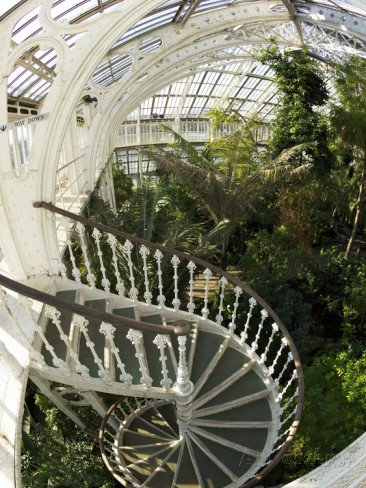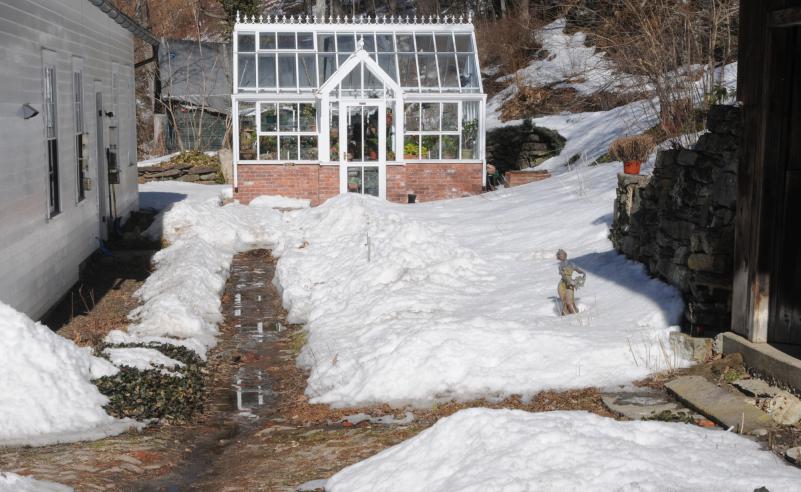I’ve been running into a lot of glasshouses in my midwinter reading. I just finished reading up about Edward VII, son of Prince Albert, who dazzled the world with the Crystal Palace in London in 1851. Albert was a better exhibition organizer than he was a father, but the book reminded me what a remarkable new technology plate glass was in the 19th century.

The famous gardens of Versailles had an orangery, described in the impishly delightful memoir of their longtime caretaker, The Gardener of Versailles. But it wasn’t really a greenhouse, in the sense that we understand the word. Even Louis XIV couldn’t afford that much glass when it had to be hand-blown in small pieces and then assembled pane by pane for a window. The stained-glass windows of medieval cathedrals were impressive not just because they were colorful but because they were glass, at a time when glass was truly rare and valuable.
But glassmaking was one of the technologies revolutionized by the Industrial Revolution. I was reminded by a 1,400 page history of New York City’s first four centuries that Teddy Roosevelt’s family got rich importing plate glass for 19th century boomtowns. Even before the steel-and-glass skyscrapers got going in the 1880s, cities like Chicago, Philadelphia, St. Louis, Cincinnati, and of course New York needed a whole lot of windows for all the buildings they were flinging up.
And one of the side inventions of the Industrial Revolution was the greenhouse. The English, with their gloomy climate, had a long tradition of tinkering to create microclimates to grow tender plants, but a glass house or even a sunny room was still an expensive luxury. In 1848, the Palm House at Kew Gardens was built with the old technology of hand-blown glass and wrought iron. But that same year a new industrial process was developed for making plate glass on an industrial scale. The Crystal Palace showed it to the world.
Soon, every new English railroad or mining millionaire—and every American millionaire who wanted to ape the English—was building an arched and peaked conservatory on his country estate. By the 1880s middle-class gardeners were building small glasshouses of their own, imitating rich gardeners under glass as they imitated them outdoors by creating small-scale parterres with hedges of coleus.
In the U.S., huge conservatories became one way booming cities showed their increasing cultural sophistication. Pittsburgh got its Phipps Conservatory in 1893, Chicago got its Garfield Park Conservatory in 1908. The rich kept on building ever larger glasshouses, such as Pierre DuPont’s conservatory at Longwood. (Oddly, Downton Abbey doesn’t seem to have a conservatory, although Highclere Castle, where the TV show is filmed, was built in 1878. Maybe the Crawleys just aren’t gardeners.)
Many of those great glasshouses are now open to the public one way or another and are still being expanded. In any city of any size, there is a conservatory in a public park where citizens can escape the winter in green dreams.
 The rich used their glasshouses as living space—and showing-off space—so the word “conservatory” tends to imply a certain scale and elegance that the workaday “greenhouse” lacks. You can wear your muddy boots in the greenhouse, but not the conservatory.
The rich used their glasshouses as living space—and showing-off space—so the word “conservatory” tends to imply a certain scale and elegance that the workaday “greenhouse” lacks. You can wear your muddy boots in the greenhouse, but not the conservatory.
Greenhouses transformed horticulture. Throughout the late 19th and 20th centuries, growers were learning how to extend the season, extend the palette of flowers they could offer for sale, extend their methods of propagating plants, and extend their greenhouses, until a modern grower’s spread now often includes acres of land under glass (or, more likely in a commercial greenhouse, polycarbonate).
There would be no poinsettias at Christmas if greenhouse growers in the 1920s had not figured out that in controlled conditions they grow large quantities of a colorful Mexican shrub. Most gardeners today don’t realize that almost any plant you buy, of any size, anywhere, has spent much of its life in a greenhouse.
Today, hobby greenhouses make it possible for anybody with a small plot of land to tinker with the climate and grow plants indoors that would die outside or wouldn’t sprout for months. More elaborate and elegant conservatories combine growing space and living space. We think of them as providing a taste of history and tradition, but we forget that they are, in fact, a modern industrial marvel.










